Beyond Flowers: How to Support Pollinators in Your Own Yard
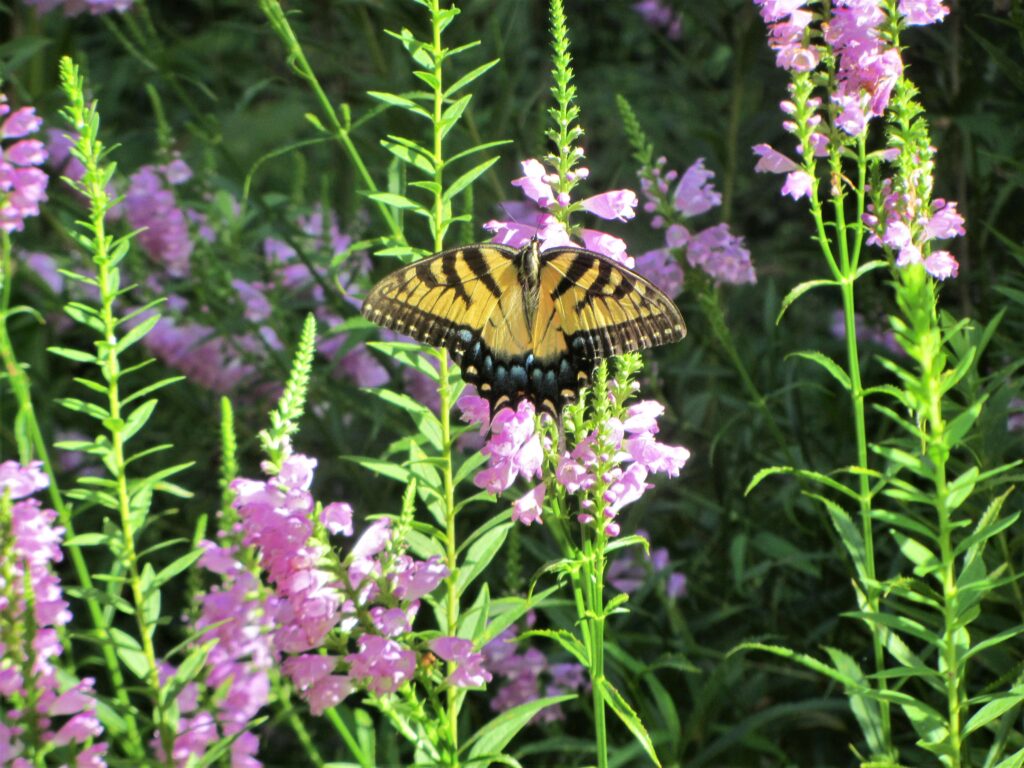
A female Eastern Tiger Swallowtail butterfly feeds on obedient plant, Physostegia virginiana.
Have you ever planned a party, set up the bar and buffet, and then felt disappointed by how few people turned up to enjoy your hospitality? We are left wondering what went wrong. Curious gardeners planting flowers to support pollinators have sometimes been left feeling that way in recent years. We plant a tempting array of all the right plants and then sit watching and waiting for hummingbirds, butterflies, bees, and other winged pollinators to swoop in to enjoy the feast. When few turn up to our flowers and feeders, we are left wondering, ‘Why? ’
Vanishing Pollinators
Has this happened to you? It seems like there are fewer and fewer butterflies each year. Master Naturalists, members of the North American Butterfly Association (NABA), and other volunteers who count butterflies each summer can validate our observations with their data. Often there are fewer species sighted as well as fewer individuals of the expected species documented in these counts.
There has been a marked decline in many species of birds, too, including hummingbirds. One of the only local bird species that hasn’t suffered from a collapsing population is the bluebird. Local bluebird populations are on the rise, perhaps because there has been an organized effort to build and properly install bluebird houses on public land. These are high quality houses with baffles to guard the entrances from snakes and other bird species. Volunteers are also placing nesting boxes for purple martins, warblers, Carolina chickadees, and wood ducks in local parks to support these bird species as well.
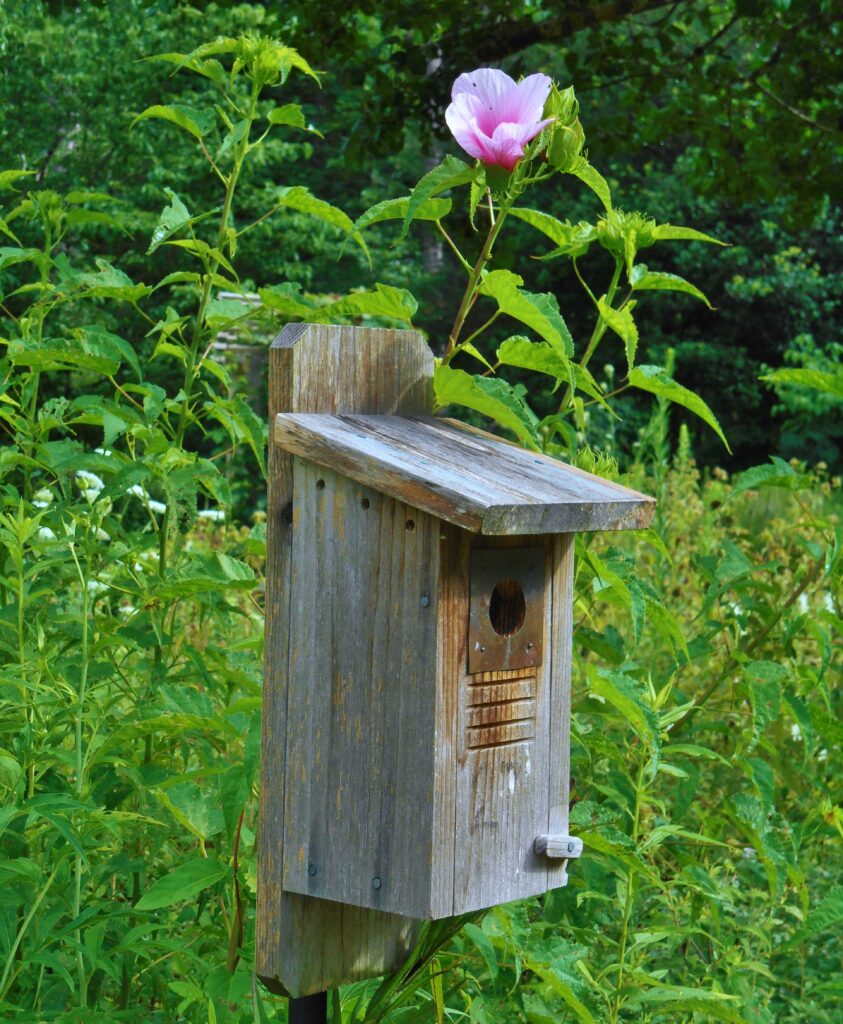
A bluebird house in the meadow helps support the population of bluebirds at the Williamsburg Botanical Garden in July 2019.
Pollinator Gardens
Gardeners have been planting annuals and perennials specifically to support pollinators for many years now. We choose flowers based on what types, often native species, experts tell us that pollinators prefer. We might have a large bed filled with black-eyed Susans, Agastache, coneflowers, Lantana, pentas, Salvias, and even a butterfly bush, and yet we could still wait for days to spot a butterfly or a hummingbird. What went wrong?
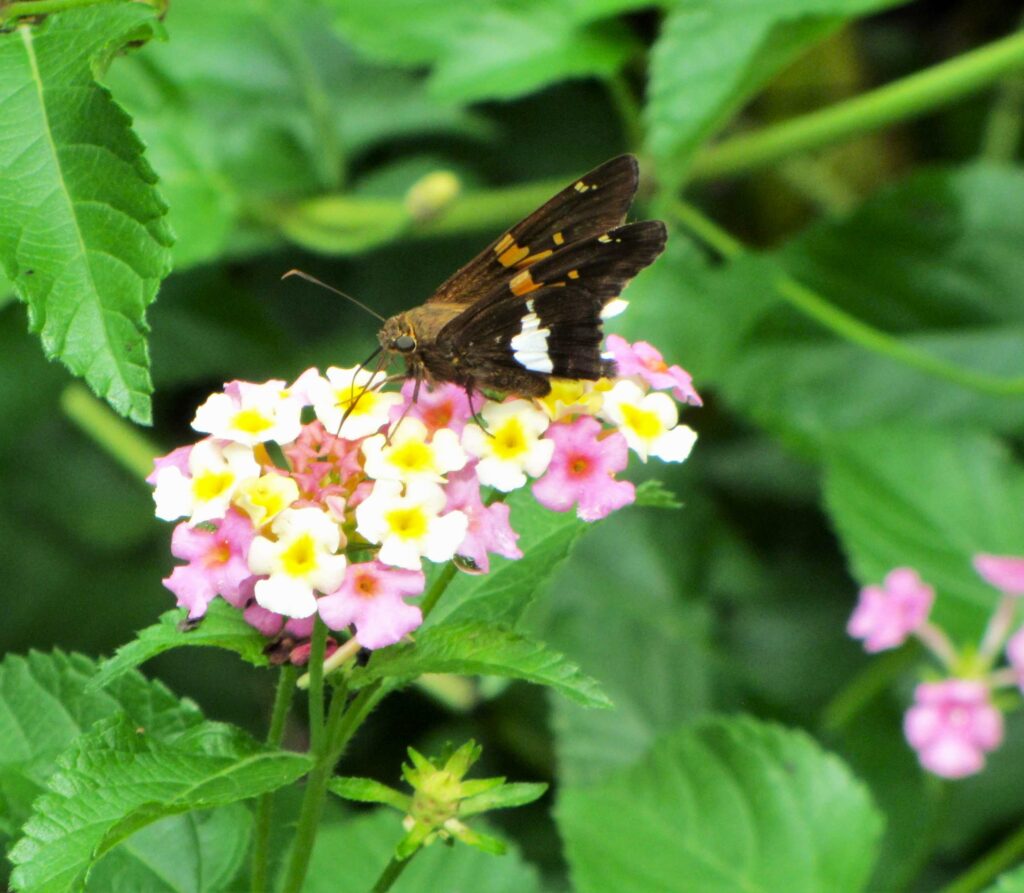
A Silver-spotted skipper feeds on Lantana camara.
Compounded Problems
A lot has been going wrong for both insect and avian pollinator populations. And serious problems that reduce the size of the next generation arise at many critical points in the life cycles of pollinators. We can provide better conditions for those individuals who visit our own gardens, but many of the toughest challenges lie beyond our control. Migrating pollinator species may have the very best conditions that we can provide, but they still run into problems during their travels and in their winter habitats.
The main problems facing pollinators fall into a few main categories: loss of habitat, pollution, and climate change. Let’s look at each of these and see what we can reasonably do to help them.
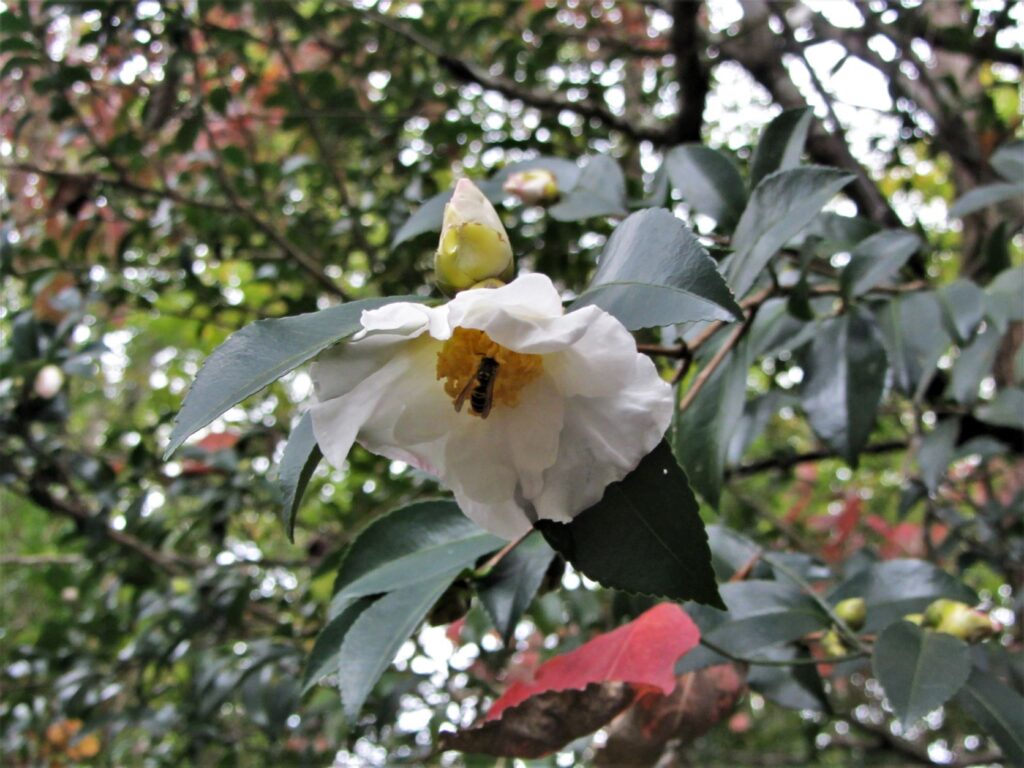
Bees feed on Camellia sasanqua late into the fall as the first frost date comes later and later each year.
Changing Climate Patterns
‘Climate chaos’ is a better term for climate change because the effects of these changes often prove unpredictable and inconsistent. While hotter than normal temperatures have been recorded in most parts of the world these last few years, the increase is uneven. We may have hotter than usual days in February and then cooler weather than expected in March and April. Overall, we have been setting record high monthly temperatures worldwide over the past year. May of 2024 was the 12th month in a row of record breaking high temperatures, the highest average temperatures recorded since records were first kept in 1850. This heat takes its toll on animals as well as on people.
The predictable patterns of monthly average temperatures and rainfall have become very unpredictable, and this is devastating for wildlife. The study of phenology examines how climate changes affect the timing of plant growth and the interactions between plants and animals. It shows that there may be a disconnect between when certain plants bloom and when pollinators are there to feed from them. Sometimes, plants like fruit trees bloom weeks early and don’t get properly pollinated. Other times, pollinators may be active on warm winter days when there is little in bloom to feed them.
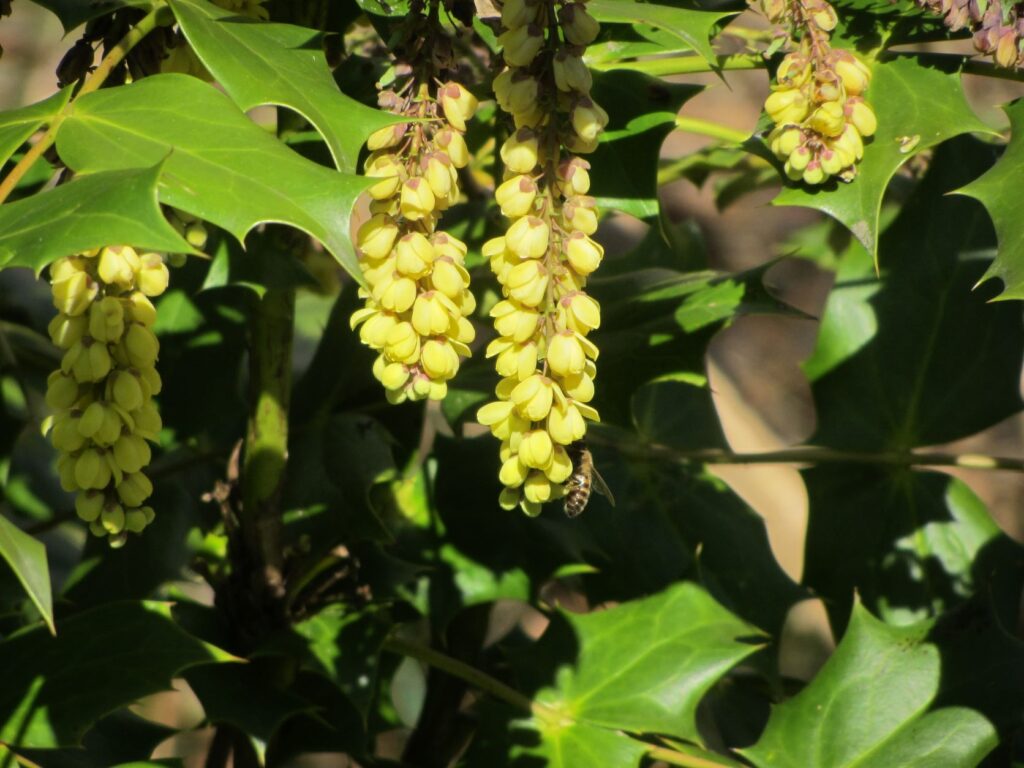
A bee feeds on Oregon grape holly in January 2022. It is important to provide winter flowers for pollinators who become active on warm winter days.
Timing is Everything…
Changes in climate may influence birds and butterflies to linger too long before starting their fall migration or to start out too early in the spring. They may not be able to find the food they need along the way when their timing is off. The very pretty and popular tropical milkweed, Asclepias curassavica, doesn’t die back in winter at the same time as native milkweed. Monarchs may breed one more time when they should be migrating. The tropical milkweed may also vector a parasite which is harmful to Monarchs.
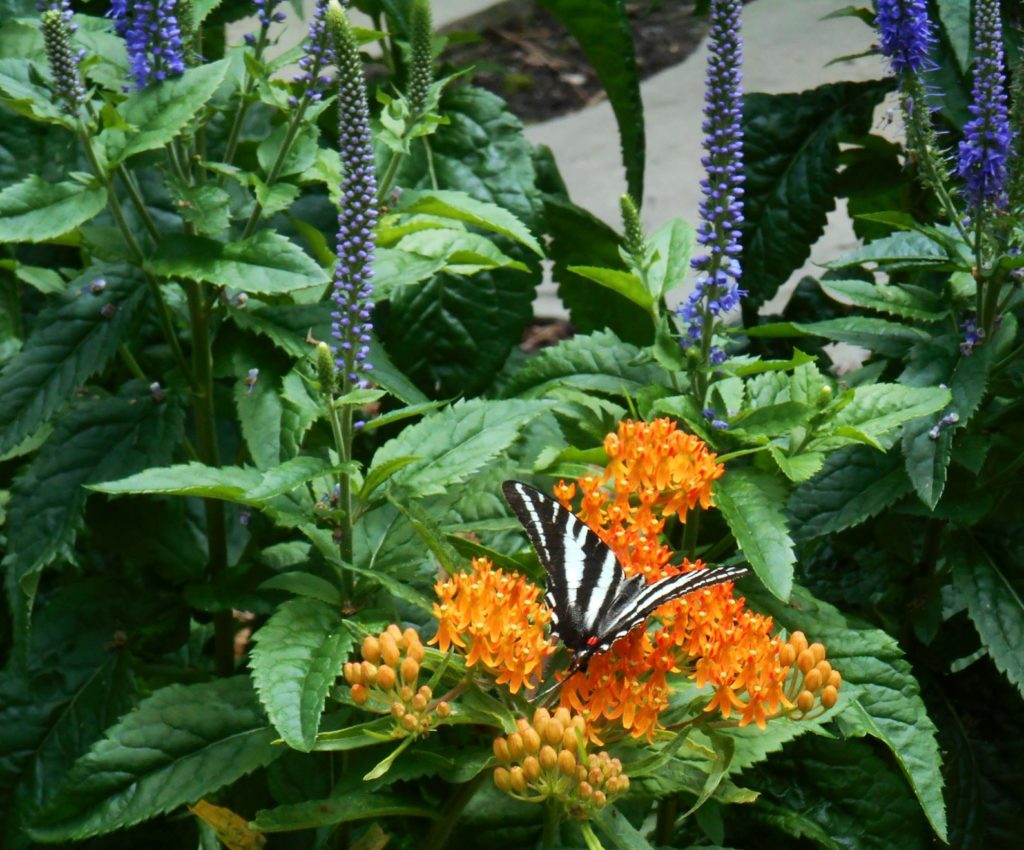
A Zebra Swallowtail butterfly feeds on native Asclepias tuberosa. This milkweed is native in the Eastern United States and supports several other species of lepidoptera as a host plant besides the Monarch butterfly. Tropical milkweed has similar flowers but its foliage is variegated. The Williamsburg Botanical Garden 2018.
More violent storms interfere with migrating animals, too. Storms may slow down migrating birds and insects, may force them to change their route, or may kill animals caught up in strong winds. While this is a problem that we can recognize and seek to understand, none of us individually can solve the problem caused by climate chaos. We can each do our best to reduce our carbon and methane footprint and to find ways to adapt to rapid change, but we can’t stop the process unfolding on our planet.

A male Ruby-throated Hummingbird feeding on native coral honeysuckle at the WBG-FPA. Hummingbirds migrate hundreds of miles each year, often through stormy weather. Photo by Jim Easton June 2023.
Preventable Pollution
The health problems caused by water and air pollution are another category of large-scale problems both for wildlife and for humans. In many cases, the sources of pollution come from energy production, manufacturing, agriculture, transportation, military activities, and local sanitation. Cleaning up the pollution requires solutions from corporations and government. Cleaning up chemicals from a river, or chemical pollution in the air, requires large-scale solutions.
But we can control chemical pollution in our own yards by reducing or eliminating the chemicals we use on our lawn, our trees, and our flower beds. Most insecticides and herbicides are systemic. We may want to kill ants or aphids, but those chemicals get into the air, into the soil, and cling to the plants. They can kill other insects and invertebrates that they contact beyond those we intend to target. Summer treatments for mosquitoes kill many insects beyond just the mosquitoes, including lightening bugs and butterflies. Even ‘organic’ pesticides are still pesticides and are designed to kill.
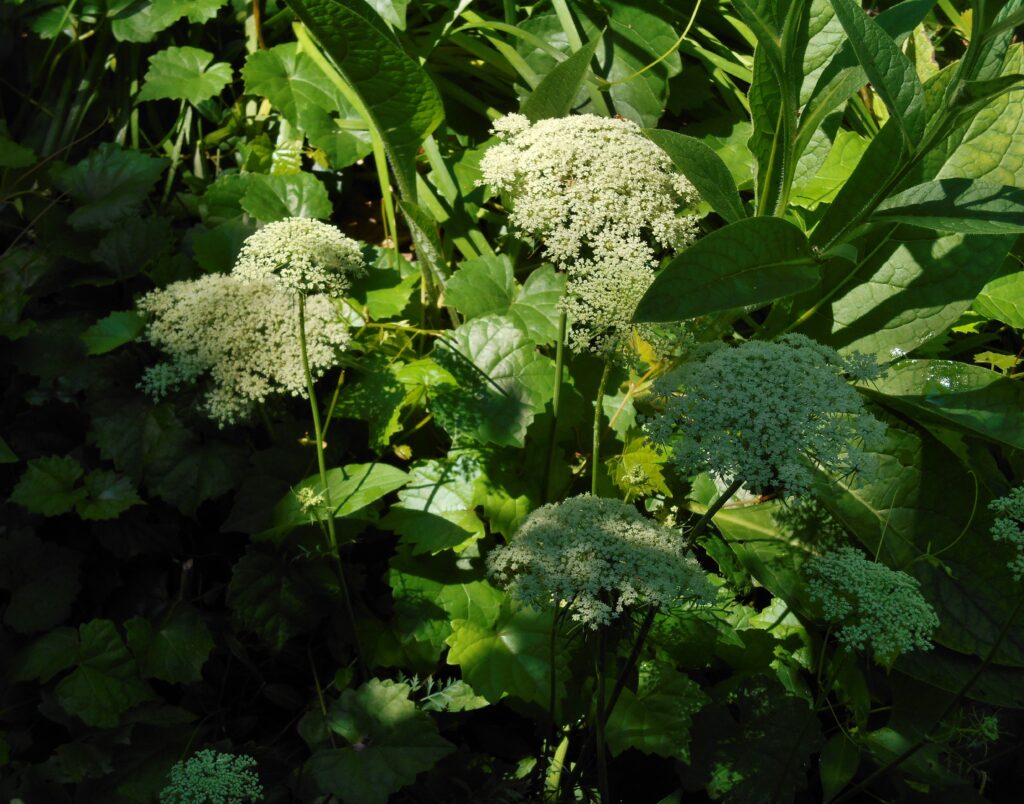
Carrots, Queen Anne’s lace, fennel, dill, parsley and rue all serve as host plants for swallowtail butterflies and nectar plants for a variety of insects. No horticultural chemicals are needed to grow herbs and Daucus carota. Plant carrots that still have their tops intact vertically in the garden to grow beautiful lacy flowers like these. Carrots, like parsley, are biennials and will bloom in their second season.
Our Duty to Care
Anyone gardening for wildlife needs to commit to stopping their use of pesticides and seriously reconsider their use of chemical fertilizers. Pesticides and strong chemical fertilizers often kill insects in their larval stage. They can also kill invertebrates living in the soil. If a caterpillar is killed before it matures then it can never fly as a butterfly or lay eggs for the next generation. While we tend to think about showy pollinators like hummingbirds and butterflies, all sorts of bees and wasps, moths, ants, beetles, and even flies pollinate certain plants in our yards.
Why would we plant flowers to attract and feed pollinators only to kill them once they show up to feed? When we leave the ecosystem to balance itself, without using pesticides, we find that the right species show up to control those insects that we consider problems. Yes, we may have some raggedy leaves where insects and insect larvae feed on the leaves of plants and leave them less than pristine. We may have webs in our trees and aphids and ants climbing on stems. Just look at those crawling guests as ‘bird food’ and know that everything can feed another creature.
Provide a Home, Not Just a Meal
Finally, a meal is not enough to attract and care for wildlife species. We also need to provide proper habitat which includes clean water, places to shelter and rest, and babysitting services for their young.
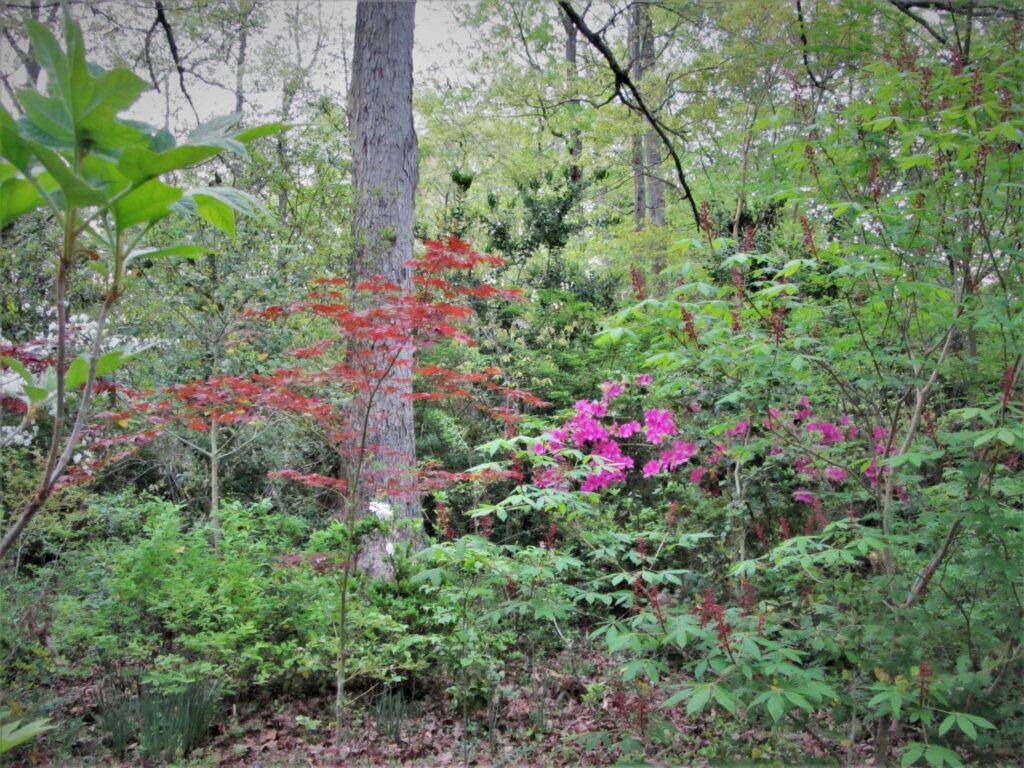
Many different layers of vegetation, and adjoining areas of sun and shade provide a safe habitat for many different birds, insects, and other small animals. A complex ecosystem provides food and habitat for for animals to raise their next generations. Trees are often the most important host plants in a garden. April 2024
We provide a safe habitat for birds and insects by providing a variety of vegetation layers in our garden where they can seek food, shelter, and nesting sites. Hummingbirds and butterflies thrive on the edges of open sunny areas. They want shrubs and trees for cover while they survey the flowers where they plan to feed. Planting perennials of various sizes, including climbing vines, and designing with a variety of shrubs, small, and large trees of various species, provides greater biodiversity to feed and shelter a greater variety of pollinator species. Birds and butterflies need protected spots to perch and scan for danger before feeding. They need safe places to sleep and shelter from storms.
Vegetation also filters, cleans, and cools the air. Every tree, shrub, and ground cover we grow is constantly filtering greenhouse gasses and other pollutants from the air and sequestering them in its own cells. This is an effective way to ‘scrub’ greenhouse gasses out of the atmosphere and store them in the roots and branches of plants. Evergreen plants continue this work through the winter, long after deciduous trees and herbaceous plants have lost their leaves. Cooling shade protects fragile pollinators and gives them a place to rest on hot summer days. This is another way we can each help to combat a warming climate.

A bee lawn will support many animal species. Daisy fleabane, dandelions, clover, plantain, purple dead nettle, violets, and other wildflowers feed pollinators and birds. Many of these common wildflowers also serve as Lepidoptera host plants. April 2024
A traditional lawn offers pollinators little food and no cover. A ‘bee lawn,’ with clover, violets, and other wildflowers may provide food and host plants for some butterflies. Open sunny areas planted with nectar rich flowers in addition to lawn, mulched areas, and even gravel provide for some of the various needs of birds and pollinating insects.
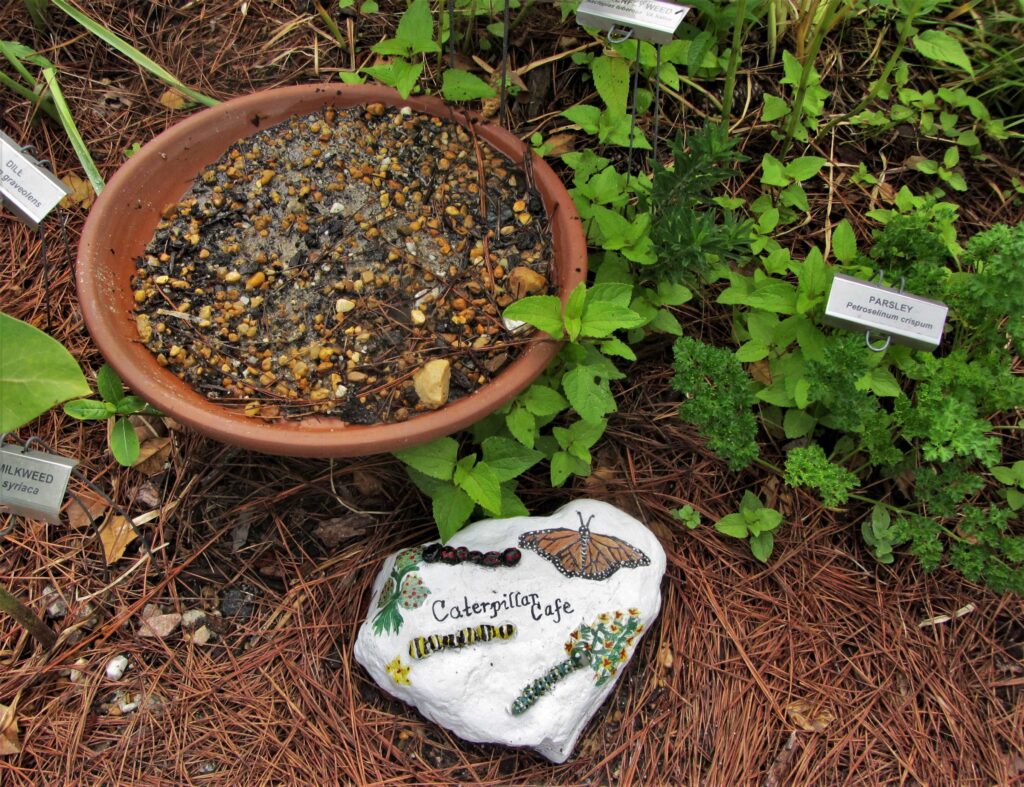
A shallow pan with water, sand, and gravel provides butterflies a place to puddle. The Pollinator Garden, Williamsburg Botanical Garden, June 2021.
Provide Food, Water, and Shelter
Provide water in shallow bowls containing a larger rock or two for perching. Offer butterflies a shallow saucer filled with damp sand and gravel for ‘puddling,’ where they take in both moisture and minerals.
Hummingbird feeders help hummingbirds drink enough liquid each day as well as to consume the sugars they need for their active metabolism. Mix one part white table sugar with four parts hot water and stir vigorously until the sugar dissolves. Don’t add any food coloring or other ingredients, which can harm the hummingbirds. Keep hummingbird feeders clean and change the liquid food frequently. Hang feeders near flowers that hummingbirds frequent, like Verbena, to help them locate the feeders, especially early in the season. Remember that hummingbirds will want a nearby perch to scan for predators before feeding.
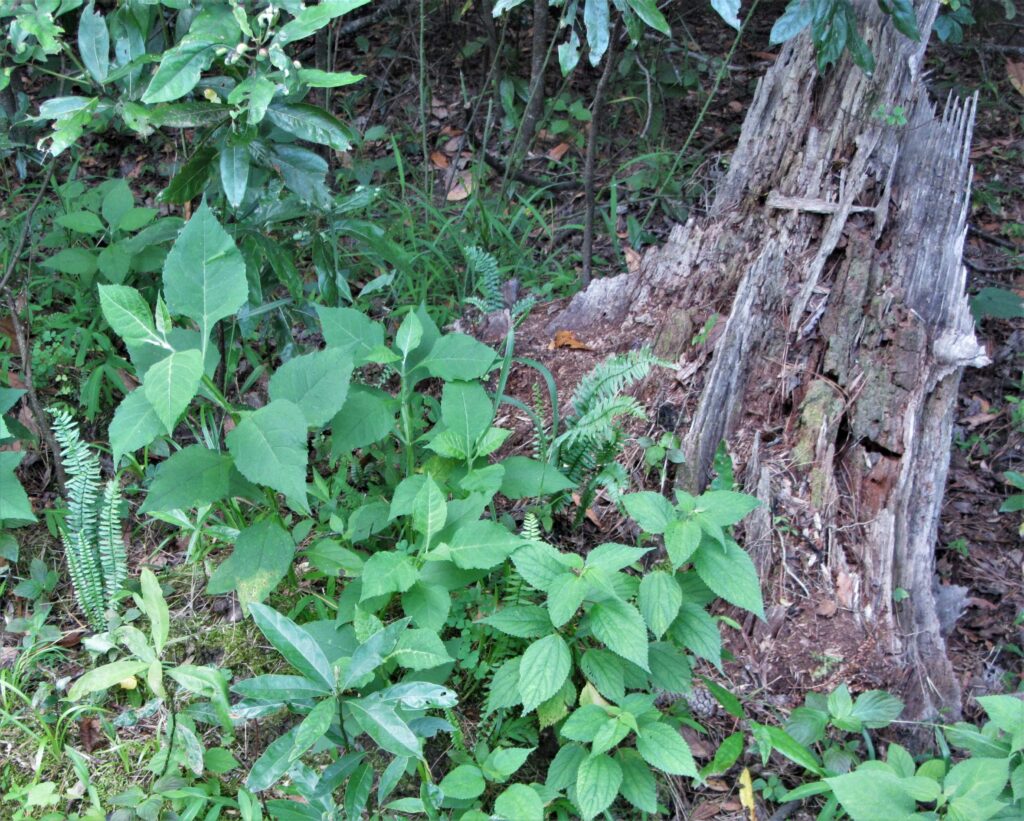
Snags provide important habitat for native bees and other insects. Birds hunt for food here, and the decaying wood enriches the soil. Jamestown Island, June 2023.
Native bees may live in the ground or in holes in dead trees. ‘Snags,’ stumps and dead trees, provide habitat for many insect species including bees and beetles. Perennial stems provide nesting sites for some bees to lay their eggs and safe spaces for their larvae to mature through fall and winter. Bee boxes, easy to build or purchase, support large numbers of native solitary bees. While these bees don’t produce honey the way that European honeybees do, they are important pollinators.
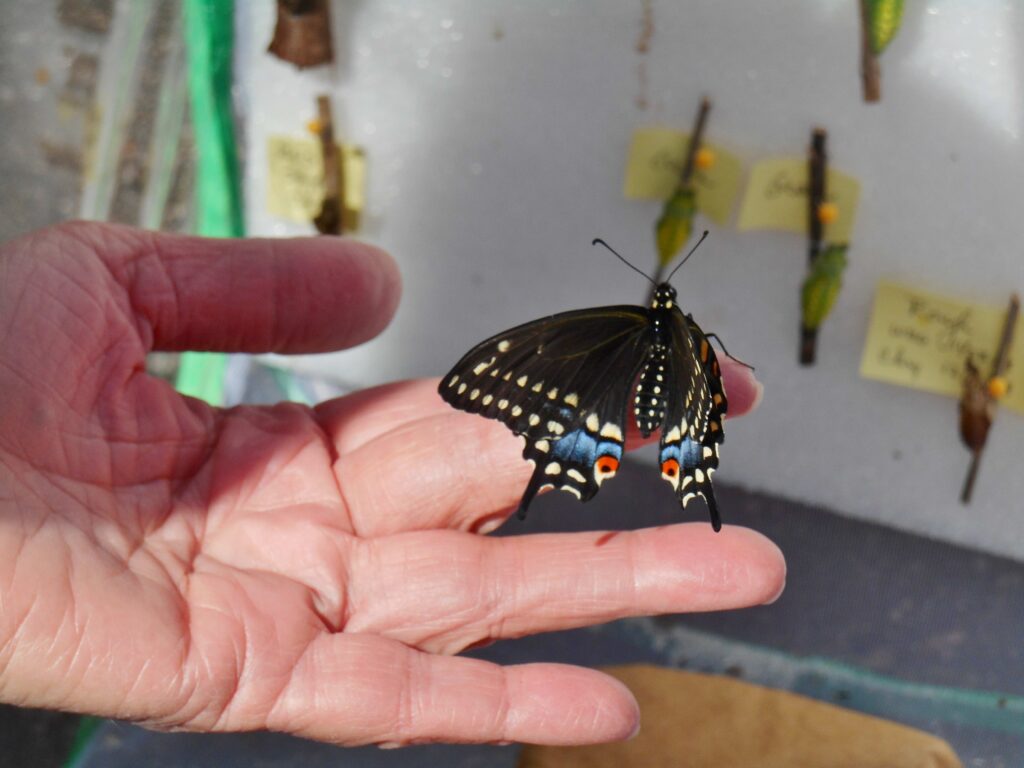
Some butterfly enthusiasts protect cocoons until they are ready to open, and then release the butterflies once their wings have dried.
A Butterfly’s Life: Egg, Larva, Pupa, Adult
Butterfly larvae need safe places to spin their cocoons while they undergo their metamorphosis to become butterflies. You will usually find these cocoons hanging near the host plants where butterfly larvae feed. It is important to watch for these, and protect them, especially when cleaning up the garden in early winter.
The cocoon and chrysalis within can feed many animals, and so some butterfly enthusiasts collect both butterfly larvae and cocoons to allow them to mature in the protection of a small tent, sold as a butterfly habitat. They release the butterflies once each emerges from its cocoon and its wings mature. Anyone who helps butterflies this way needs to properly care for any larvae they collect, providing the correct host plants and a water source. They also monitor the cocoons closely to release the butterflies as soon as they are ready to fly.
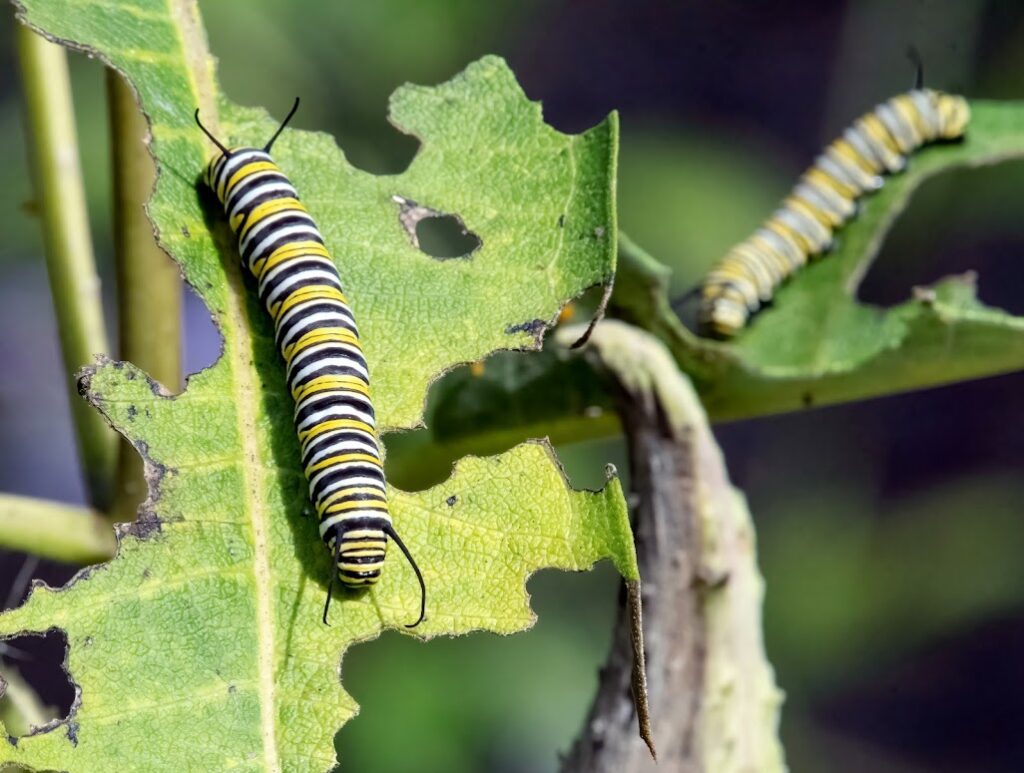
Monarch caterpillars feed on milkweed leaves at the Williamsburg Botanical Garden, September 2022. Photo by Jim Easton
Host Plants Feed the Young
Growing appropriate host plants for butterflies, and other insect larvae, may be the best thing home gardeners can do to support our butterfly populations. While butterflies may be willing to sip nectar from most flowers they find, their larvae are particular about which plants to eat. Grow a group of several plants together to catch the attention of butterflies so they will lay eggs. A single plant may not be noticed, or be enough to support the larvae during their growth.
Monarch butterflies, which only eat Asclepias or milkweed species, use phytochemicals in milkweed to make their own bodies poisonous to predators. This is one way they survive. Other poisonous butterfly species, like the Pipevine Swallowtail, also lay their eggs only on their required host plants, which contain certain poisonous phytochemicals, for similar reasons. Poisonous pipevines, Aristolochia ssp., are their host plant.
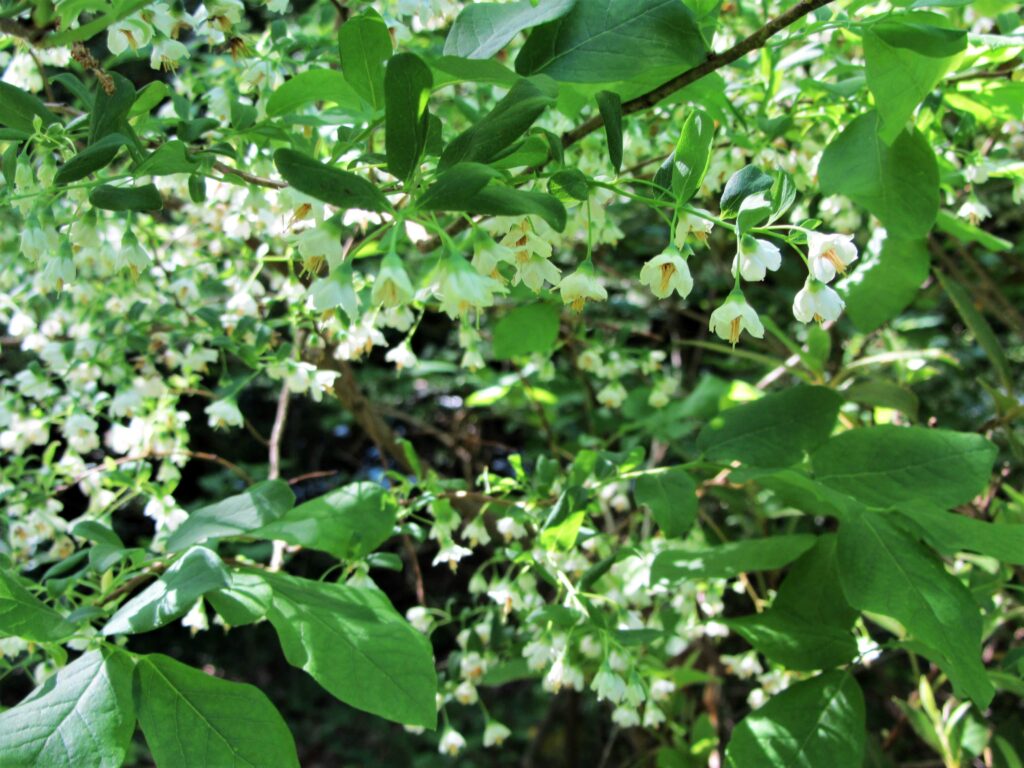
Native vaccinium ssp. shrubs support a variety of pollinators in early spring and serve as a host plant for over 200 Lepidoptera species throughout the season. Shrubs like this deerberry are a keystone species in our area and often volunteer from seeds dropped by birds.
While some butterfly and moth species will only lay their eggs on a single species, like the Monarch, most other butterfly species found in our area can use a variety of native, and some non-native plants, as hosts. It is smart to get a good idea of the common butterflies in our area and then plant specific host plants to support their larvae.
Keystone Plants Host Many Lepidoptera Species
Some keystone plants may host hundreds of butterfly and moth species. Many larval caterpillars can all grow and develop from the leaves of these native trees, shrubs, and perennials. White oak trees host around 430 caterpillar species. Maple, black cherry, pine, river birch, and hickory all host 200 or more different caterpillar species. Native Vaccinium shrubs, all related to blueberries, host over 200 caterpillar species.
We enjoy several different large, showy swallowtail butterflies in our area. While the Eastern Tiger Swallowtail is one of the most recognizable and most common, we also have the Spicebush Swallowtail, Black Swallowtail, and Zebra Swallowtail. Swallowtails will lay their eggs on a variety of both native and non-native host plants. Although all the swallowtail species won’t use all these plants, here is a list of common host plants for swallowtails: parsley, dill, fennel, rue, caraway, carrot, thistle, Queen Ann’s Lace, tulip tree, wild black cherry tree, sweet bay Magnolia, lilac shrubs, pawpaw trees, sassafras, pipe vine, and spice bush. Most of these serve as both host plants and sources of nectar.
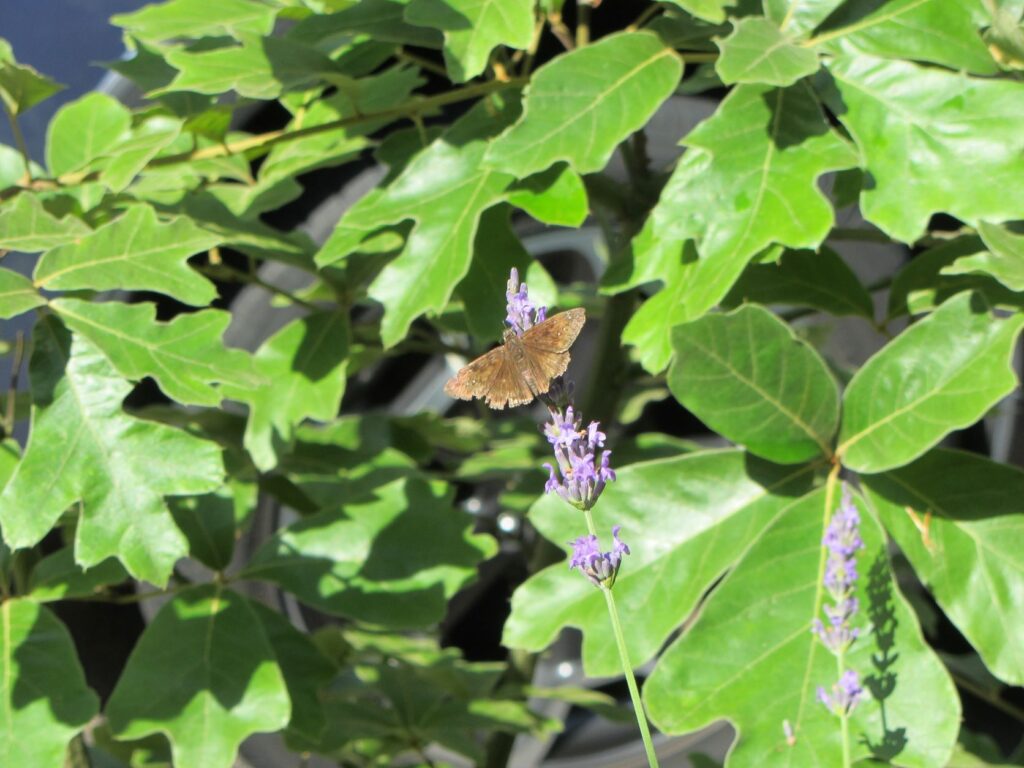
A Skipper butterfly feeds on lavender flowers growing near a young southern red oak. Oak trees host over 430 Lepidoptera species, more than any other tree in our bioregion. A single oak tree can support and shelter thousands of insects in addition to birds and squirrels. Its acorns are one of the most important foods to support many animals, like deer and squirrels, through the winter.
Know Your Butterflies and Bees
The Historic Rivers Chapter of the Virginia Master Naturalists and the Coastal Virginia Wildlife Observatory have confirmed more than 80 butterfly species during their annual butterfly counts. Of these, there are perhaps 50 species most often sighted, including the Cabbage White, the Cloudless Sulphur, the Viceroy, the Pearl Crescent, the Common Buckeye, and the Painted Lady butterflies. Interestingly, several of these species depend on wildflowers like plantain, clover and violets, that grow in our lawns, as their host plants. Others use various trees and shrubs like willows, along with snapdragons, hollyhocks, coneflowers, and asters. Some even use pea or bean plants! Find a list of common host plants used by Virginia’s butterflies on the Piedmont Environmental Council’s website.

A Silver-Spotted Skipper rests on coral honeysuckle at the Williamsburg Botanical Garden and Freedom Park Arboretum. Photo by Jim Easton May 2024. The honeysuckle is a larval host for the Spring Azure Butterfly and the Snowberry Clearwing Moth.
Yes, We Can Contribute to Positive Change
So, each of us with even a small yard can make a positive impact to help support insect and avian pollinators by planting host plants as well as nectar plants, by providing nectar plants through the winter, by planting our gardens in layers to provide habitat for wildlife, by providing clean water for wildlife, and also by committing to stop using pesticides and herbicides in our own yards. Our small efforts to reduce pollution and to nurture a variety of plant and animal life will help heal the planet and allow declining animal populations to recover. We can reverse the losses of recent years by providing safe spaces for animals to reproduce and raise their young. We can provide safe resting spots where animals can stop and feed along their East Coast migration routes.
Wisdom comes as we realize what things we can control, and what we cannot. While climate chaos, habitat loss in other places, and industrial pollution may be beyond our own personal control; how we plant and manage our own yard is our choice to make. We can each make a positive difference for pollinators and other wildlife by maintaining welcoming, safe, nurturing spaces for them to live and to raise their young.
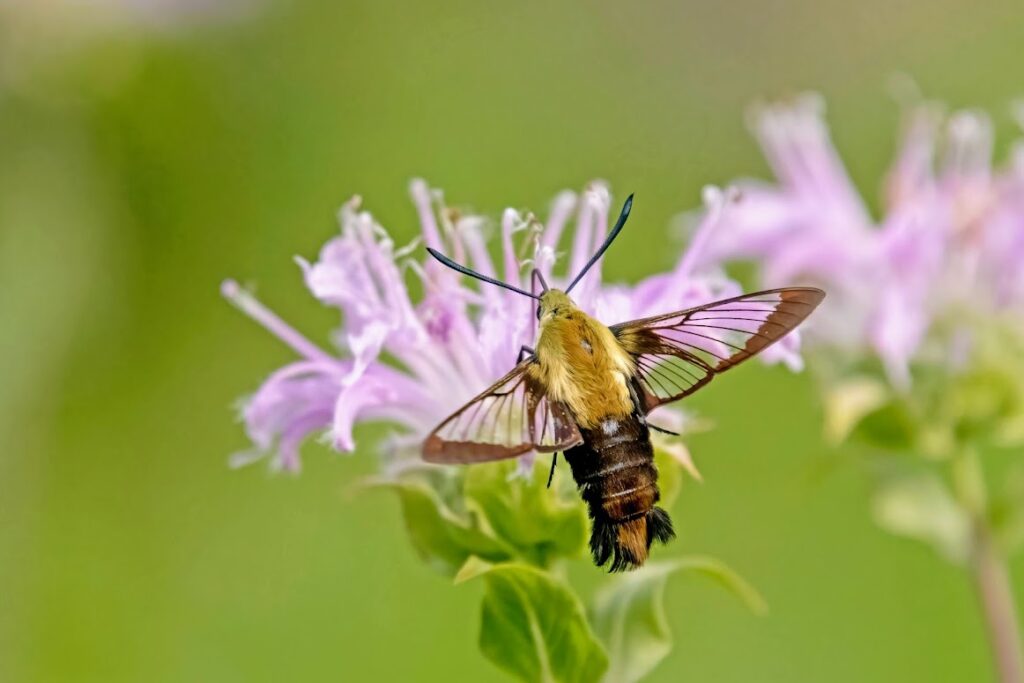
A Snowberry Clearwing Moth feeds on Monarda at the Williamsburg Botanical Garden and Freedom Park Arboretum. Photo by Jim Easton July 2023.
Photos by E. L. McCoy and by Jim Easton, Master Naturalist.
Resources for More Information:
Digital Atlas of the Flora of Virginia
Native Plants for Southeast Virginia Including Hampton Roads Region. Second edition 2017.
Wilson, Edward O. “The Little Things That Run the World (The Importance and Conservation of Invertebrates).” Conservation Biology. Vol. 1, No. 4. (Dec. 1987) pp. 344-346.
Brock, Jim P. and Ken Kaufman. Kaufman Field Guide to Butterflies of North America. Mariner Books. 2006.
Mellichamp, Larry. Native Plants of the Southeast: A Comprehensive Guide to the Best 460 Species for the Garden. 2014.
McCoy, Elizabeth. “How to Create a Haven for Hummingbirds.” JCCWMG.org. 2023.
McCoy, Elizabeth. “Invitation to a ‘Homegrown National Park‘.” Jccwmg.org website. 2022.
Oudolf, Piet and Henk Gerritsen. Planting the Natural Garden. 2019.
Tallamy, Douglas. Nature’s Best Hope: A New Approach to Conservation That Starts in Your Yard. 2020.
Tallamy, Douglas. “Container Gardening with Keystones.” Homegrown National Park.org website. 2023
Vogt, Benjamin. A New Garden Ethic: Cultivating Defiant Compassion for an Uncertain Future. 2017.



